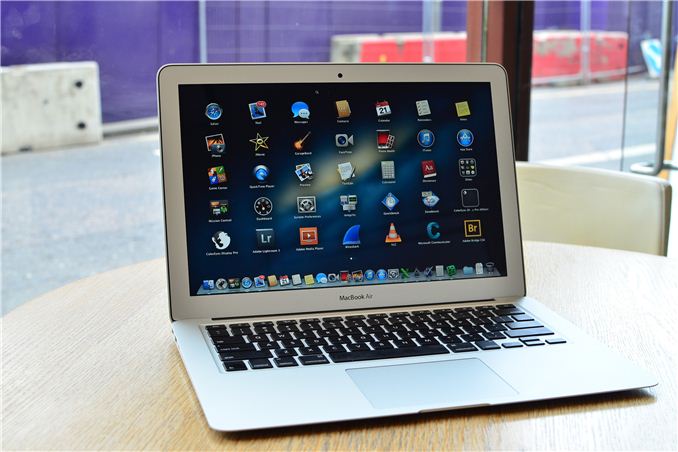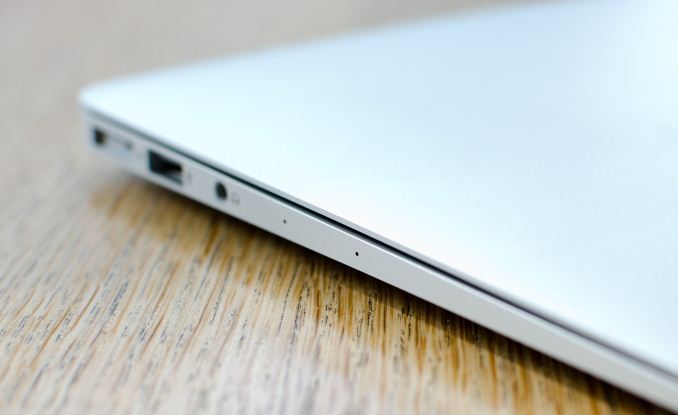The 2013 MacBook Air Review (13-inch)
by Anand Lal Shimpi on June 24, 2013 12:01 AM EST
Things didn’t go exactly as I’d expected at WWDC. I spent the week before the show at Computex, talking to PC OEMs, who had all just launched their Haswell ULT based Ultrabooks. With a couple of exceptions however, the bulk of Haswell ULT systems weren’t scheduled to ship until later this year. Even the Acer S7 I snagged while in Taipei was still a pre-production unit, with final hardware due out in the next month. Based on what I saw in Taiwan, and Intel having seeded me an Iris Pro machine the week before, I assumed that the MacBook Pro with Retina Display is what would get the Haswell treatment first. Obviously, that didn’t happen.
In hindsight, the move makes sense. Apple will sell far more MacBook Airs than rMBPs. The Apple/Intel relationship is looking very healthy these days, so it’s also not surprising that it would have supply and early enough access to Haswell ULT to launch the MBAs at WWDC with almost immediate availability. The Haswell ULT shift didn’t require a new chassis for Apple, which meant a less complex development process.
From the outside, the new MacBook Air looks nearly identical to its predecessor. There's a second mic opening on the left side of the machine now, but otherwise you'd be hard pressed to tell this year's model apart from the previous generation. Internally, nearly everything has changed.
The battery is higher capacity, with no increase in weight. Making better use of that larger battery is Intel's new Haswell ULT silicon. Since we're talking about a ULT part, the PCH moves from the motherboard to the CPU package - creating an emptier motherboard than we've seen in previous years:
The 2013 13-inch MacBook Air Motherboard, Courtesy iFixit
It's clear to me that the MBA is due for a more significant redesign, but this is not the year for that.
Alongside Haswell comes a brand new PCIe SSD, 802.11ac support and LPDDR3 memory. All at a price equal to, if not less than last year's models:
| 2013 MacBook Air Lineup | ||||||
| 11.6-inch | 11.6-inch (high-end) | 13.3-inch | 13.3-inch (high-end) | |||
| Dimensions |
H: 0.11-0.68" (0.3-1.7cm)
W: 11.8" (30cm) D: 7.56" (19.2cm) |
H: 0.11-0.68" (0.3-1.7cm)
W: 12.8" (32.5cm) D: 8.94" (22.7cm) |
||||
| Weight | 2.38 lbs (1.08kg) | 2.96 lbs (1.35kg) | ||||
| CPU | 1.3GHz dual-core Core i5 | 1.3GHz dual-core Core i5 | ||||
| GPU | Intel HD 5000 | |||||
| RAM | 4GB LPDDR3-1600 | |||||
| SSD | 128GB PCIe SSD | 256GB PCIe SSD | 128GB PCIe SSD | 256GB PCIe SSD | ||
| Display Resolution | 1366 x 768 | 1440 x 900 | ||||
| Ports | Thunderbolt, 2x USB 3.0, headphone jack | Thunderbolt, 2x USB 3.0, SD card slot, headphone jack | ||||
| Networking | 2x2:2 802.11ac | 2x2:2 802.11ac | ||||
| Battery | 38 Wh | 54 Wh | ||||
| Price | $999 | $1199 | $1099 | $1299 | ||
We've been over the MacBook Air chassis thoroughly in the past so I won't go through it again here. Build quality remains excellent. The clickpad and backlit keyboard never give me any troubles either. It's sad that we're still having clickpad issues elsewhere in ultraportables but this is one area where Apple's vertically integrated advantage is apparent (as is the company's willingness to spend a little extra on even the little details).
The only thing that hasn't changed, that perhaps should have is the display. The MacBook Air retains the same 1366 x 768/1440 x 900 panels from last year, while much of the competition has moved to at least 1080p IPS in the 13.3-inch form factor. This year at Computex we saw a number of systems move to 2560 x 1440 13.3-inch panels, at least as an option, however I'm expecting those systems to be priced more in line with the 13-inch rMBP rather than the MacBook Air. Admittedly, I don't know the right solution here.Ultra high resolution panels drive cost and power consumption up, the latter which can be offset by going to a larger battery - but then you have a 13-inch rMBP. Perhaps the right move for the MacBook Air would be for Apple to move to IPS panels at least? Or maybe we see a merger of the 13-inch MBA/rMBP, and something new entirely replace the 11-inch model.












233 Comments
View All Comments
doobydoo - Tuesday, June 25, 2013 - link
Sigh @ Ignorant people who compare processors of different architectures by GHz.TheinsanegamerN - Sunday, June 30, 2013 - link
the boost clocks are similar, and the haswell boosts way more than ivy bridge did. look at the cpu scores, which are similar, despite the 400 mhz reduction.Krysto - Monday, June 24, 2013 - link
Disappointing to see that even Apple has started being misleading about its battery life for laptops.It seems unlike Steve Jobs, Tim Cook is more of a "regular manager" who prefer spec lists and bullet points, over being truthful to customers. Now they're just lying about battery life numbers just as every other PC OEM out there - 12h of battery life! (but you might actually get only half of that).
And all that with a CPU that is 20 percent slower than last year, and a GPU that's twice as big but only 10-20 percent better than last year.
Also, the dual core Haswell chip alone costs $350? Yikes. So you still think these chips have any chance of competing in the tablet space, Anand? The whole of iPad Mini costs less than that, with a sub $30 chip. Intel is as behind as always when it comes to competing in the mobile space.
madmilk - Monday, June 24, 2013 - link
Sheesh, at least read the review. The battery life is 11 hours on the light workload, which is certainly more than half of the advertised 12. This difference is easily accounted for by the higher screen brightness and Flash. The 1.3GHz Haswell is not 20% slower either than the comparable 1.7GHz Ivy. More like 5% at worst, and in several cases faster. The GPU is 20% faster in a _much_ lower TDP, once the FIVR and PCH are accounted for, which contributes to the very impressive battery life on the heavy workload as well. As for Haswell pricing -- ULV i5/i7 are in another league compared to any ARM offering on the market. Atoms and Celerons are more appropriate for the toy tablet market.Sushisamurai - Tuesday, June 25, 2013 - link
... If you read the fine print on apple's website, they increased the benchmark demands on the MBA compared to previous battery tests just to make the 12 hrs seem more realistic. CNET and a few other sites posted their battery tests of the 13" to be rated for 14+ hours. I think anand already made a point about this...And if you compare ARM A9's & ARM A15's performance to intel's haswell platform... You would know ARM processors really can't compete on the same level. There's a reason for that price difference
lyeoh - Monday, June 24, 2013 - link
OK, so which review site is better? So that we can go read it as well...whyso - Monday, June 24, 2013 - link
You know what would be nice. GPU benchmarks for the rmbp 13" or HD 4000 from a standard voltage part to see how it compares to the HD 5000.tipoo - Monday, June 24, 2013 - link
Agreed. It can be confusing when the ULV parts have the same name as normal TDP parts and perform significanlty differently.tecsi - Monday, June 24, 2013 - link
Could these MBAs support external 4k displays given the Intel 5000? There appears to be a new Thunderbolt part—is this Thunderbolt 2? I am surmising that this support could be turned on in MBAs when the Mac Pro arrives with Mavericks, along with potentially Apple 4k displays.tipoo - Monday, June 24, 2013 - link
Not Thunderbolt 2. Only the new Mac Pro has that right now.